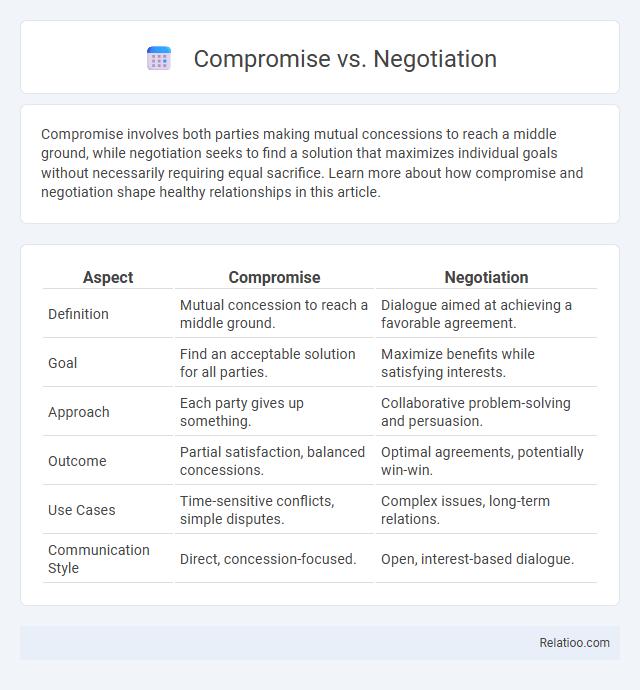Compromise involves both parties making mutual concessions to reach a middle ground, while negotiation seeks to find a solution that maximizes individual goals without necessarily requiring equal sacrifice. Learn more about how compromise and negotiation shape healthy relationships in this article.
Table of Comparison
| Aspect | Compromise | Negotiation |
|---|---|---|
| Definition | Mutual concession to reach a middle ground. | Dialogue aimed at achieving a favorable agreement. |
| Goal | Find an acceptable solution for all parties. | Maximize benefits while satisfying interests. |
| Approach | Each party gives up something. | Collaborative problem-solving and persuasion. |
| Outcome | Partial satisfaction, balanced concessions. | Optimal agreements, potentially win-win. |
| Use Cases | Time-sensitive conflicts, simple disputes. | Complex issues, long-term relations. |
| Communication Style | Direct, concession-focused. | Open, interest-based dialogue. |
Understanding Compromise and Negotiation
Understanding compromise involves both parties making mutual concessions to reach a common agreement, prioritizing collaboration to balance interests. Negotiation encompasses a broader process of communication and bargaining where each party aims to maximize their outcomes while seeking a workable solution. Both skills are essential in conflict resolution, with compromise emphasizing give-and-take and negotiation focusing on strategic dialogue.
Key Differences Between Compromise and Negotiation
Compromise involves each party making concessions to reach a mutually acceptable agreement, often resulting in a middle ground that may not fully satisfy either side. Negotiation is a broader process where parties communicate, propose, and adjust terms to achieve the most favorable outcome, which may include win-win solutions without necessarily requiring concessions. Unlike compromise, negotiation emphasizes strategy and collaboration to maximize value and address underlying interests rather than merely settling differences.
The Role of Communication in Both Processes
Communication plays a crucial role in both compromise and negotiation by facilitating mutual understanding and clarity of interests. Effective dialogue ensures that parties accurately express their needs, listen actively, and explore possible solutions that can lead to agreement. In compromise, communication often centers on finding middle ground, while negotiation involves more strategic exchange to maximize outcomes for all involved.
Benefits of Compromise: When to Choose It
Compromise offers the benefit of achieving a middle ground quickly, making it ideal for resolving conflicts where maintaining relationships and reaching a solution are priorities. It helps prevent escalation by encouraging concessions from all parties, fostering cooperation and mutual respect. Choosing compromise is effective in situations with limited time or resources, where a perfect outcome is less critical than a timely agreement.
Advantages of Negotiation: Optimal Situations
Negotiation offers the advantage of creating optimal situations by allowing both parties to collaboratively reach a mutually beneficial agreement that addresses core interests rather than simply splitting differences. Unlike compromise, negotiation fosters creative problem-solving, leading to innovative solutions that maximize value for all stakeholders involved. This approach enhances long-term relationships, promotes trust, and increases the likelihood of sustainable outcomes in business, diplomatic, and interpersonal contexts.
Common Misconceptions About Compromise and Negotiation
Common misconceptions about compromise and negotiation often confuse the two as identical processes, but they serve distinct purposes in conflict resolution. Compromise involves mutual concession, where both parties yield some demands to reach an agreement, while negotiation is a broader dialogue aimed at finding a satisfying outcome without necessarily sacrificing key interests. Understanding these differences helps you navigate disputes more effectively by recognizing when to stand firm and when to find middle ground.
Real-Life Examples: Compromise vs Negotiation
Negotiation involves a strategic dialogue where both parties aim to reach a mutually beneficial agreement, such as when two businesses discuss contract terms to maximize profits. Compromise requires each side to make concessions, like roommates agreeing on shared chores to maintain harmony. In real-life scenarios, your ability to differentiate between negotiation's collaborative problem-solving and compromise's give-and-take approach determines the efficacy of conflict resolution.
Skills Needed for Effective Negotiation
Effective negotiation requires strong communication skills to clearly articulate interests and actively listen to others' perspectives, fostering mutual understanding. Emotional intelligence enables negotiators to manage emotions and build rapport, facilitating collaborative problem-solving and trust. Strategic thinking and adaptability are essential for identifying creative solutions and adjusting tactics to achieve mutually beneficial agreements.
Strategies for Balancing Compromise and Negotiation
Balancing compromise and negotiation requires strategic communication, active listening, and clear goal-setting to ensure that both parties achieve mutual benefits without sacrificing core interests. Employing collaborative problem-solving techniques helps you identify underlying needs, fostering creative solutions where concessions are balanced and win-win outcomes are prioritized. Maintaining flexibility and patience throughout the process strengthens relationships and builds trust while navigating conflicting priorities effectively.
Choosing the Right Approach: Factors to Consider
Choosing the right approach between compromise and negotiation depends on your goals, priorities, and the context of the situation. Compromise often works well when both parties need a quick resolution and are willing to make concessions, while negotiation is better suited for achieving mutually beneficial outcomes without sacrificing key interests. Your decision should factor in the importance of the relationship, time constraints, and the level of flexibility each party has.

Infographic: Compromise vs Negotiation
 relatioo.com
relatioo.com